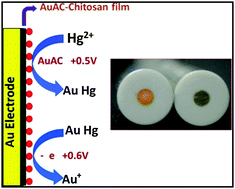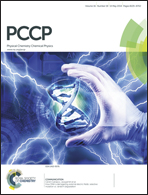Electrochemical synthesis of a gold atomic cluster–chitosan nanocomposite film modified gold electrode for ultra-trace determination of mercury†
Abstract
Gold atomic cluster based nanocomposites are important in the field of energy and sensing applications due to their interesting optical, electronic, chemical and catalytic properties. In the present study a chitosan stabilized gold atomic cluster nanocomposite was synthesised by a simple electrochemical technique based on the anodic dissolution of a gold electrode in the presence of a cationic surfactant, cetyl trimethyl ammonium bromide (CTAB), and a biopolymer, chitosan, on a gold electrode. The gold clusters formed were characterized by DLS, TEM, MALDI-TOF-MS, XPS, fluorescence and cyclic voltammetry. The developed gold atomic cluster–chitosan (AuAC–Chit) nanocomposite modified gold electrode was highly sensitive and selective for the electrochemical detection of Hg(II) ions. It offers a wider calibration range of 10−14–10−7 M with a limit of detection (LOD) of 0.8 × 10−14 M and a limit of quantification (LOQ) of 6.6 × 10−14 M, much below the guideline value of 1 × 10−8 M stipulated by United States Environmental Protection Agency (USEPA), accompanied by a good precision of 1.06% for 10−13 M of Hg(II). The designed sensor is selective to Hg(II) ions in the presence of other coexisting species.


 Please wait while we load your content...
Please wait while we load your content...